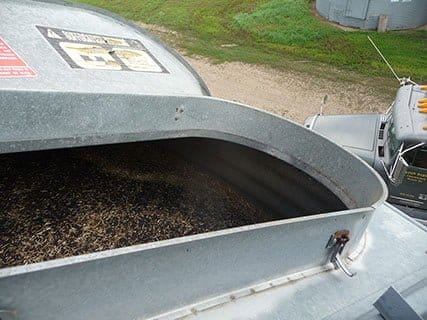 Ultrasonic level sensors depend on strong echoes to detect a surface and measure the distance. They’re ideal for liquid level sensing where the surface is typically flat and reflective. Because of this, our listed ultrasonic sensor ranges are for liquids.
Ultrasonic level sensors depend on strong echoes to detect a surface and measure the distance. They’re ideal for liquid level sensing where the surface is typically flat and reflective. Because of this, our listed ultrasonic sensor ranges are for liquids.
Solids offer a target that is often uneven and less reflective. An ultrasonic may still be a good choice, but the range will change based on how the echoes are affected.
For example, solids often pile up in the center where they are poured into a bin. This creates an uneven surface that will weaken the echoes returning to the sensor. If the solid is either powdery or dusty, it will absorb and dissipate some of the sound energy coming from the sensor. This weakens the return signal and effectively reduces the range at which the sensor can do its job.
The same holds true for liquids that produce light vapors or a little foam. A longer range ultrasonic can perform well at shorter ranges. However at some point, vapor, foam, dust, or powder can all absorb too much of the sound signal and require a different sensor technology to take an accurate measurement.
As a general rule of thumb, the sensor’s range drops by as much as half when dealing with challenging (but acceptable) environments. We would recommend a different technology when there is heavy dust, very light powders, thick vapor, or when there is consistently more than a little foam.
When using an ultrasonic for bulk solid level measurement, make sure you program the sensor for optimal performance. You can boost the Pulses to increase the power of the sound wave, and turn up Sensitivity to better recognize a weakened signal. Take caution, however, that you balance the two settings to improve sensor lifespan and reduce false positives.
Before you rely on sensor programming, make sure you get a sensor with double the needed range to reduce the amount of boosting required.
There are a variety of other settings that you can use to optimize the performance of your ultrasonic level sensor. To learn more about ultrasonic sensor programming, get access to our guide titled, “18 Programmable Settings You Need In An Ultrasonic Sensor”.
Reach out to us if you have any questions about ultrasonic level sensors or how to select and program them for your unique application. We’ll help you get the right combination for reliable performance. And if your application isn’t a good fit, we’re not afraid to tell you.